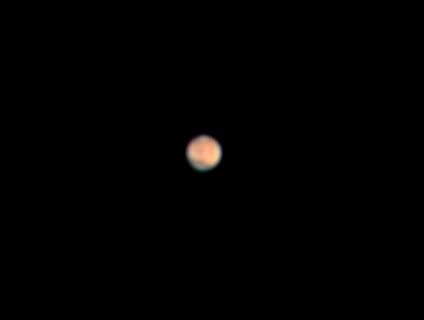
Mars is a harsh, rugged, dry planet. However, the surface of Mars reveals features that support the conclusion that Mars once had large amounts of flowing water long ago in its history. In addition, images from the Mars Global Surveyor spacecraft suggest that liquid water has flowed on the surface of mars in the recent past. Mars also has water vapor in its atmosphere. In the Martian winter, the northern polar ice cap includes layers of solid frozen water and frozen carbon dioxide. The ice cap at the south pole is frozen carbon dioxide. Mars has a thin atmosphere and the low pressure would cause liquid water on the surface to boil and evaporate. Thus, the evidence of recent water flows is curious, and must have involved large amounts of water suddenly being relesaed from below the surface.
Mars orbits the Sun in about 687 days. A Martian day lasts 24 hours and 37 minutes. Mars is smaller than the Earth. The planet's diameter is 4,220 miles at the equator, as compared to the Earth's 7,930 mile diameter. In addition, Mars has only 0.11 the mass of the Earth. Consequently, the surface gravity is only about a third of the Earth's gravity. A person who weighed 100 pounds on the Earth would only weigh 38 pounds on Mars.
This is a composite RGB CCD image taken with a Takahashi FS-128 refractor. An SBIG ST-8E CCD with a CFW-8 color filter wheel was used for imaging.
Constellation: Virgo
RA: 14h 00m 49.5s Dec: -11d 07' 08"
April 30, 1999
Image by Sid Leach
Iola, Texas
Recent Images.
Complete list of images.
Description of equipment used to acquire images.
Home
Feedback and comments should go to Sid